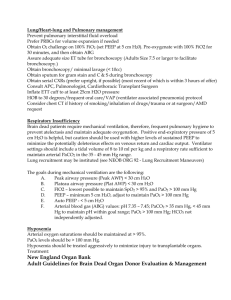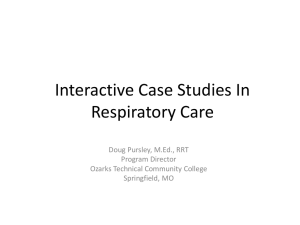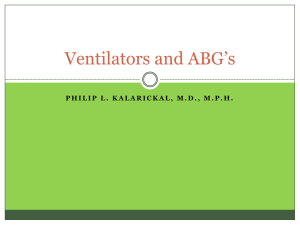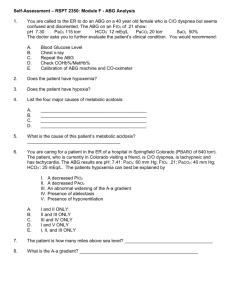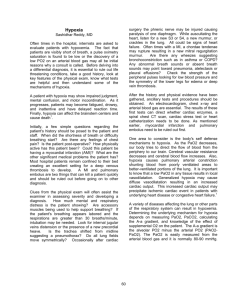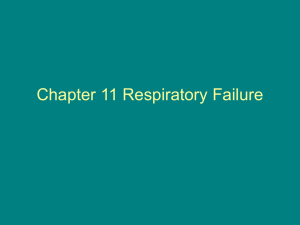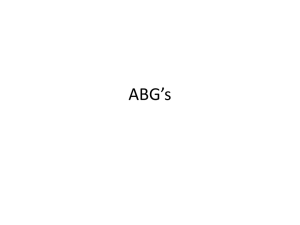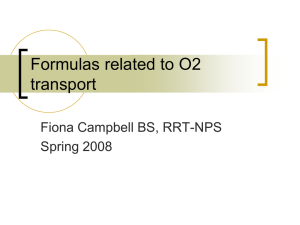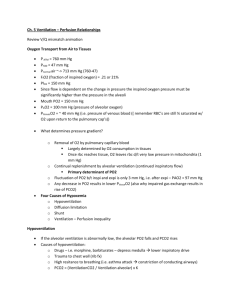Arterial Blood Gas - Macomb
advertisement
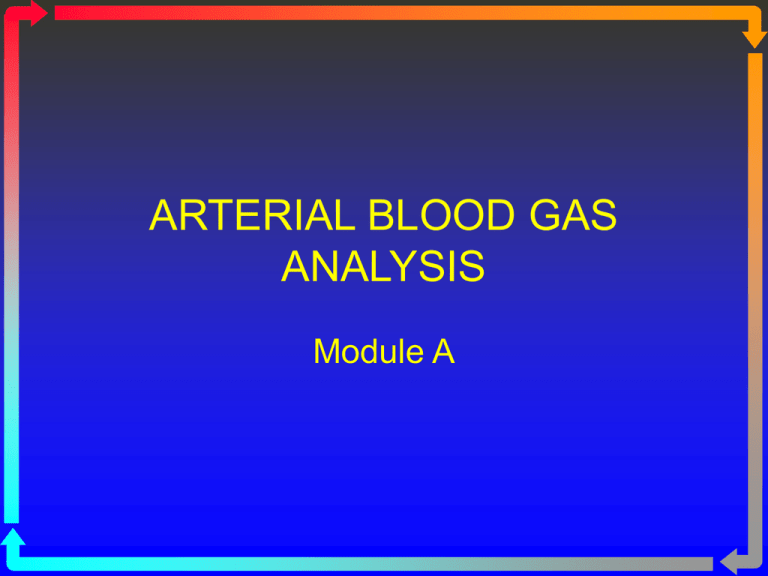
ARTERIAL BLOOD GAS ANALYSIS Module A Objectives • List the normal values for parameters found in a blood-gas analysis. • List the normal values for parameters found in a CO-Oximetry analysis. • Differentiate between measured and calculated (derived) blood gas data. • List the three physiologic processes assessed with blood gas data. • State the PaCO2 equation. • Describe how alveolar minute ventilation is derived. • Describe the relationship between PaCO2, CO2 production and Alveolar Minute Ventilation. Objectives • Describe the effects of altitude on partial pressure, barometric pressure and fractional concentrations. • Given appropriate data, use Dalton’s Law to determine the resultant partial pressures of a gas in a mixture. • Given appropriate data, calculate the Alveolar Air Equation. • Explain how changes in the PIO2 or PaCO2 levels affect the PAO2. • State the formula for Oxygen Content and Oxygen Delivery. Arterial Blood-Gas Analysis • Two Components • Acid Base Balance/Ventilation • pH, PaCO2, HCO3-, BE • Electrolytes (primarily K+) • Oxygenation • PaO2, Hb, CaO2, SaO2, MetHb%, COHb% & any other abnormal Hemoglobin species. • Oxygenation Indices: PaO2/FIO2, A-aDO2, s/ t. Acid-Base Balance • Non-Respiratory Acid Base Component (Metabolic Indices) • HCO3• BE • Respiratory Indice (Respiratory Index) • PaCO2 Definition of Blood-Gas • Any element or compound that is a gas under ordinary conditions and dissolves in the blood. • A blood-gas would exert a partial pressure • • • • O2 CO2 N2 CO Technology • Blood can be analyzed on either or both of two different machines (or one machine with two distinct components) • Blood-Gas Analyzer • CO-oximeter Measured vs. Derived • Most values are directly measured with various electrodes: • Clark: PO2 • Severinghaus: PCO2 • Sanz: pH • Some are calculated or derived Values are: • HCO3• Base Excess (BE) • CaO2 Normal Values • • • • • pH: 7.35 – 7.45 PaCO2: 35 – 45 torr PaO2: 80 – 100 torr SaO2: 97% HCO3-: 22-26 mEq/L • %MetHb: < 2% • %COHb: < 2% • Smokers: 5 – 10% • BE: +/- 2 mEq/L • CaO2: 18 – 20 vol% * Vol% = mL/100 mL of blood Hemoglobin Saturation • %SaO2 + %COHb + %MetHb 100% • Example of error: • SaO2 97%, %COHb 50%, MetHb% 0% Interpretation of an ABG • Three Areas of information are necessary • Information about the patient’s immediate environment. • Additional Lab Data. • Clinical Information obtained through patient assessment. Interpretation of an ABG • Immediate Environment • • • • • FIO2 Barometric Pressure Toxic gases/smoke Level of consciousness Environmental information • Empty Pill Bottle • Accident Interpretation of an ABG • Lab Data • • • • • • • Previous analyses Hemoglobin or hematocrit (from lab) Electrolytes (K+, Na+, Cl-) Blood Glucose Blood Urea Nitrogen (BUN) Chest x-ray PFT test Interpretation of an ABG • Clinical Information • • • • • History and physical exam. Vital Signs. Respiratory effort & ventilatory pattern. Mental Status. State of tissue perfusion. Assessing Oxygenation • FIO2 • Barometric Pressure • Age Composition of the Environment • These values stay constant even with changes in barometric pressure. Dalton’s Law of Partial Pressures • All pressures in a gas mixture must add up to the total pressure (PBARO). • Dry Gas • Pgas = PBARO x FIO2 • Inspired Gas (ex. PIO2) • Pgas = (PBARO - 47 torr) x FIO2 Calculating Partial Pressures for dry gases • PO2 = 760 x .21 160 mm Hg or torr • PN2 = 760 x .78 593 mm Hg or torr • PCO2 = 760 x .0003 0.23 mm Hg or torr • PAr = 760 x .0093 7 mm Hg or torr NOTE: 160 + 593 + .23 + 7 = 760 Altitude’s Effect on Partial Pressure High Altitude Response • Increase Altitude • PBARO PIO2 PAO2 PaO2 • To adapt to high altitudes • Change the environment • Airplanes are pressurized to 7000-8000 feet. • Increase FIO2 (above 20,000 feet). • Adapt Physiologically • • • • Hyperventilation. Collateral Circulation. Shift the oxygen dissociation curve. Increase Hemoglobin levels. Calculating PBaro at High Altitudes • PBARO falls 120 mm Hg per mile of altitude • Example: Leadville is 2 miles above sea level. Calculate the PBARO & PO2 • 120 x 2 miles = 240 mm Hg decline • 760 - 240 = 520 mm Hg (PBARO) • PO2 = 520 x .21 109 mm Hg or torr (PO2) Physiologic Processes • ABG results provide information on the three physiologic processes • Alveolar Ventilation • Acid-Base • Oxygenation Equations Used to Reflect the Physiologic Processes • PaCO2 Equation Alveolar Ventilation • Henderson Hasselbalch Acid Base • Alveolar Air Equation Oxygenation • Oxygen Content (CaO2) Oxygenation • Oxygen Delivery Oxygenation PaCO2 and Alveolar Ventilation • Alveolar Ventilation is the amount of air in L/min that reaches the alveoli and takes part in gas exchange. • VA VE VD • The body eliminates the CO2 produced, during metabolism, via ALVEOLAR ventilation. Metabolism • Steady State • The amount of CO2 added to the blood through metabolism = the amount of CO2 excreted by the lungs. • 200 mL/min PaCO2 Equation • PaCO2 = CO2 production x 0.863 Alveolar Minute Ventilation • 0.863 is a constant which equates dissimilar units. • 40 mm Hg = 200 mL/min x 0.863 4.3 L/min PaCO2 Equation • If CO2 production doubles (e.g. fever), alveolar minute ventilation must double to keep a normal PaCO2 level. • 40 mm Hg = 400 mL/min x 0.863 8.6 L/min Henderson-Hasselbalch Equation • pH is defined as the negative log of the H+ concentration • pH = pK + Log HCO3(Base) (PaCO2 x 0.03) (Acid) • pH = pK + Log 24.0 mEq/L 1.20 mEq/L • “Normal” pH implies 20 times more base than acid PAO2 • PAO2 = PBARO – 47 torr x FIO2 – PaCO2 0.8 • PAO2 = PIO2 - PaCO2 0.8 • PAO2 on room air = 100 – 104 mm Hg • PAO2 on 100% = 600’s Effects of PaCO2 on PAO2 and PaO2 • A rise in the PaCO2 will lower the PAO2 and therefore the PaO2. • Hypoventilation is a cause of hypoxemia. CaO2 • CaO2 = (SaO2 x Hb x 1.34) + (PaO2 x 0.003) • With normal values: • Oxyhemoglobin (attached) represents 19.7 vol%. • Dissolved oxygen (PaO2) represents 0.3 vol%. • Total Oxygen present in the blood 20 vol%. Vol % • mL of oxygen/100 mL of blood Or • mL of oxygen/dL of blood Oxygen Delivery • • • • Oxygen Delivery = CaO2 x CO x 10 Oxygen Delivery = CaO2 x SV x HR x 10 Normal Value = 1,000 mL/min Represents amount of oxygen delivered to the tissues each minute. Factors that Influence Oxygen Delivery to the Tissues • • • • • SaO2 Hb PaO2 Stroke Volume Heart Rate Summary of Important Points •ABG interpretation means evaluating the acid base and oxygenation status of the patient. •Acid Base represent the metabolic and respiratory indices. •FIO2 stays the same regardless of changes in PBaro. •PBARO decreases as altitude increases. •Dalton’s Law. •PO2 is affected by FIO2, PBARO and age. Summary of Important Points • PAirway = PBARO. • To interpret an ABG you need 3 areas of information. • Oxygen delivery is influenced by five factors. • ABG values are either measured or derived. • Understand the 5 equations and the relationship among the parameters used.
